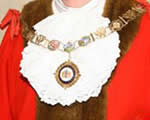 Go to main content
Go to main content
Archive Website of the UK government
Please note that this website has a UK government accesskeys system.
Main menu
Page menu
Government, citizens and rights

Mayors

There are two types of mayor with different roles. Many local councils have a mayor for ceremonial duties, who is chosen by the councillors. A few councils have an elected mayor with the power to make decisions, who is chosen by the public.
Ceremonial mayors
Some districts have the ceremonial title of borough or city, granted by royal authority. Traditionally, their councillors choose a mayor (in Scotland a provost) to act as presiding officer and to perform civic ceremonial duties.
The mayor represents the district at ceremonial and social events, meets important visitors, and chairs council meetings. Their role is non-political and they can not make decisions about council business. Mayors wear a gold chain of office and a red robe on special occasions.
In the City of London and certain other large cities, they are known as the Lord Mayor. In Scotland, the presiding officer of the council of the four longest established cities (Aberdeen, Dundee, Edinburgh and Glasgow) is called the Lord Provost.
In local councils which don't have borough or city status, there is a chairman of the council instead of a mayor, who performs the same functions.
Elected mayors
New decision-taking structures for local authorities in England and Wales were introduced in the Local Government Act 2000, including the option of a directly elected mayor.
Elected mayors are responsible for the day-to-day running of local services. They are voted for by local people, and serve for four years. They provide political leadership to the council and the community, and carry out the local authority's policies.
The best known elected mayor is the Mayor of London, who heads the Greater London Authority - not to be confused with the Lord Mayor of London. However, the Mayor of London has wider, more strategic powers than other elected mayors.
Systems of leadership
In most local authorities the arrangements are based on one of three executive frameworks:
- a mayor and cabinet
- a council leader and cabinet
- a mayor and council manager
Within these options, local authorities have flexibility to work under a constitution that reflects local circumstances. Most English and Welsh local authorities have opted for a style of executive where the leader of the cabinet is chosen by other councillors.
Small district councils with a population of less than 85,000 also had the choice of reforming their existing committee system.
Referendums for an elected mayor
Provisions in the Local Government Act 2000 required councils in England and Wales to hold binding referendums if, following consultation, local people indicated that they wanted to directly elect a mayor under the new executive arrangements.
Councils may choose to hold a referendum, but local residents can also force a referendum with a petition signed by at least five per cent of registered voters in the area.
Although the Government has powers to direct a local authority to hold a referendum in certain circumstances, in June 2002 it announced that it would not intervene in cases where it did not agree with the judgement made by a council following consultation.
 Facebook
Facebook Twitter
Twitter StumbleUpon
StumbleUpon Delicious
Delicious Reddit
Reddit

